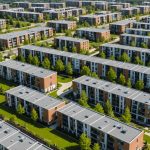Smart Financing Strategies for London Homeowners: Transforming Your Home with a Green Retrofit
Why Green Retrofitting is a Must for London Homeowners
In the heart of London, where historic buildings stand alongside modern architecture, the need for energy efficiency and a transition to a green economy has never been more pressing. With the UK government’s ambitious targets to achieve net zero carbon emissions by 2050, homeowners are increasingly looking for ways to transform their homes into energy-efficient, low-carbon havens. Green retrofitting is not just a trend; it’s a necessity in the face of climate change.
The Impact of Climate Change on Homes
Climate change is no longer a distant threat; it’s a reality that affects us all. Rising temperatures, more frequent extreme weather events, and the escalating cost of energy make it imperative for homeowners to adapt. Green retrofitting involves upgrading your home with energy-efficient features such as solar panels, heat pumps, and improved insulation. This not only reduces your carbon footprint but also lowers your energy bills in the long term.
Additional reading : Unlocking Funding Opportunities: A Guide for Rural Scottish Property Owners to Maximize Government Grants for Home Renovations
Understanding Green Finance Options
Green finance is a crucial component of any green retrofit project. It involves using financial instruments and mechanisms to support environmentally friendly investments. Here are some key green finance options available to London homeowners:
Green Mortgages
Green mortgages offer preferential interest rates or other incentives to homeowners who invest in energy-efficient improvements. For instance, some lenders provide lower interest rates for homes with high Energy Performance Certificate (EPC) ratings. This is a win-win situation, as you get to save on your mortgage while also reducing your energy consumption.
Topic to read : Your guide to finding the perfect real estate agency in spain
Government Incentives
The UK government has introduced several schemes to support the transition to low-carbon homes. For example, the Green Homes Grant provides vouchers to cover up to two-thirds of the cost of energy-efficient home improvements, up to a maximum of £5,000. Additionally, the Renewable Heat Incentive (RHI) offers quarterly payments over seven years for households that install renewable heating systems like heat pumps.
Private Investments
Private investors and companies are also stepping up to support green retrofit projects. For example, Investissements RPC has committed significant funds to various green energy projects, including investments in renewable energy infrastructure and energy-efficient building solutions[1].
Steps to a Successful Green Retrofit
Embarking on a green retrofit project can seem daunting, but breaking it down into manageable steps makes it more achievable.
Assess Your Home’s Energy Efficiency
Before you start, it’s essential to assess your home’s current energy efficiency. This can be done through an EPC assessment, which provides an EPC rating from A to G. Homes with lower ratings have more room for improvement.
Identify Areas for Improvement
Here are some key areas to focus on:
- Insulation: Proper insulation can significantly reduce heat loss and energy consumption.
- Heating Systems: Consider replacing traditional carbon heating systems with heat pumps or solar thermal systems.
- Windows and Doors: Upgrade to energy-efficient windows and doors to minimize heat loss.
- Solar Panels: Installing solar panels can generate electricity and reduce your reliance on the grid.
Choose the Right Financing Option
Here is a detailed list of financing options you might consider:
- Green Mortgages:
- Lower interest rates for energy-efficient homes.
- Specialized mortgage products for green home improvements.
- Government Grants and Incentives:
- Green Homes Grant: Vouchers for energy-efficient improvements.
- Renewable Heat Incentive (RHI): Quarterly payments for renewable heating systems.
- Private Investments:
- Loans from private lenders specializing in green finance.
- Crowdfunding platforms focused on sustainable projects.
Plan Your Project
Once you’ve identified the areas for improvement and chosen your financing option, it’s time to plan your project. Here are some steps to follow:
- Consult Professionals: Hire architects, engineers, or energy auditors to assess your home and recommend the best improvements.
- Set a Budget: Determine how much you can afford to spend and stick to your budget.
- Choose Materials and Technologies: Select materials and technologies that are energy-efficient and sustainable.
- Execute the Plan: Start the retrofitting process, ensuring that all work is done to high standards.
Case Studies and Success Stories
Real-life examples can provide valuable insights and inspiration for your own green retrofit project.
Example: Green Retrofit in Northern Ireland
In Northern Ireland, a homeowner transformed their 19th-century home into an energy-efficient haven by installing solar panels, a heat pump, and advanced insulation. With the help of a green mortgage and government incentives, they managed to reduce their energy bills by 50% and achieve a high EPC rating.
Example: London Homeowner’s Journey
A London homeowner decided to retrofit their home by replacing the old heating system with a heat pump and installing double-glazed windows. They secured a green mortgage with a lower interest rate due to the energy-efficient improvements. The homeowner reported a significant reduction in energy consumption and lower energy bills, alongside a substantial increase in the home’s value.
Table: Comparing Green Finance Options
Here is a comparative table to help you understand the different green finance options available:
| Finance Option | Description | Benefits | Eligibility |
|---|---|---|---|
| Green Mortgages | Specialized mortgages offering lower interest rates for energy-efficient homes. | Lower interest rates, increased home value. | Homes with high EPC ratings. |
| Green Homes Grant | Government vouchers covering up to two-thirds of the cost of energy-efficient improvements. | Up to £5,000 in vouchers. | UK homeowners, especially low-income households. |
| Renewable Heat Incentive (RHI) | Quarterly payments over seven years for renewable heating systems. | Long-term financial support. | Homeowners installing renewable heating systems. |
| Private Green Loans | Loans from private lenders specializing in green finance. | Flexible repayment terms, competitive interest rates. | Homeowners with a good credit score. |
| Crowdfunding | Platforms allowing multiple investors to fund your green retrofit project. | Community support, potential for lower interest rates. | Projects with clear environmental benefits. |
Overcoming Common Challenges
While green retrofitting offers numerous benefits, there are also some challenges to consider.
Access to Financing
One of the main barriers to green retrofitting is accessing the necessary financing. Here are some tips to overcome this:
- Explore Government Incentives: Utilize government grants and incentives to reduce the financial burden.
- Consider Green Mortgages: Look into green mortgage options that offer lower interest rates.
- Private Investors: Approach private investors or crowdfunding platforms.
High Upfront Costs
Green retrofitting often requires significant upfront costs, but the long-term savings can be substantial.
- Long-Term Savings: While the initial cost may be high, the long-term energy savings can offset this.
- Increased Home Value: Energy-efficient improvements can significantly increase your home’s value.
- Health Benefits: Improved insulation and heating systems can also enhance indoor air quality and overall health. and Future Outlook
Green retrofitting is not just a smart financial strategy; it’s a necessary step towards a sustainable future. As the UK moves towards its net zero carbon target, homeowners in London and beyond have a critical role to play.
Alongside Strategy and Support
The government, alongside private investors and financial institutions, is providing significant support for green retrofit projects. This includes new financing options, incentives, and regulations aimed at encouraging energy efficiency.
Market Trends and Opportunities
The market for green finance is growing rapidly, with more lenders offering green mortgage products and investors seeking sustainable projects. This trend is expected to continue, making it an opportune time to invest in green retrofitting.
As Sean Fitzpatrick, CEO of Lighthouse, emphasized in a different context but relevant here, “We have only scratched the surface of the possibilities that make data and tools more performant, accessible, and affordable”[2]. This sentiment applies equally to the realm of green finance and retrofitting, where innovation and accessibility are key to driving the transition to a low-carbon economy.
In conclusion, transforming your home with a green retrofit is a smart, sustainable, and financially savvy decision. With the right financing strategies, support from government and private sectors, and a clear understanding of the benefits, you can make your home not only more energy-efficient but also a valuable asset for the future.
Local Resources and Expert Advice
In navigating the world of green retrofits, tapping into local resources and connecting with experts is crucial. Engaging with local organizations that focus on sustainability can provide valuable insights and opportunities. These organizations often possess intimate knowledge of the area’s regulations, financial aid options, and sustainable technologies, ensuring homeowners make informed decisions.
Connecting with Experts
Enlisting the help of professionals who specialize in green retrofits can significantly impact the success of both financing and implementation. Expert consultation involves not only executing retrofit projects effectively but also aligning them with regional climate strategies. Look for consultants or firms with a proven track record in sustainable building practices, as they will offer tailored advice and innovative solutions.
Community Support and Networks
Moreover, being part of homeowner networks dedicated to sustainability can be incredibly beneficial. These networks provide a platform for sharing experiences, challenges, and solutions. By connecting with others, homeowners may discover new financing options, learn about local policies, and gain insights into effective green technologies. Engaging with the community fosters a spirit of cooperation and enables resource sharing, helping everyone achieve more sustainable homes. Building these connections not only enhances individual projects but also strengthens the broader movement towards a greener future.











